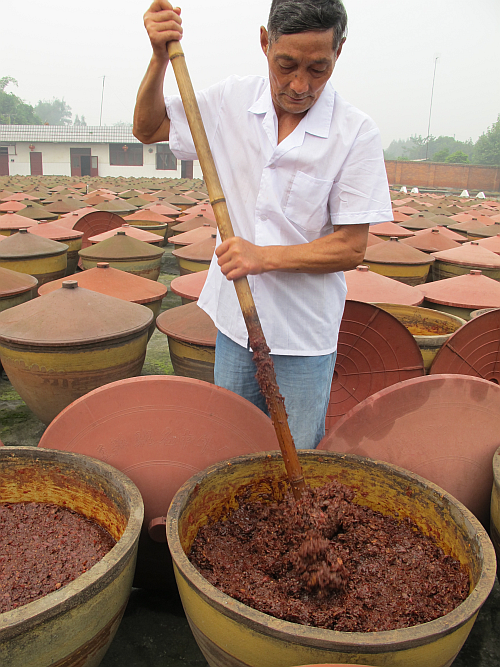Sichuan cuisine is known for its fiery dishes flavored with garlic, chilies, scallions and Sichuan peppercorn. Many recipes rely on a spicy fermented bean paste known as La Dou Ban Jiang (辣豆瓣酱), considered the soul of Sichuan cooking, for added depth and flavor. The most prized doubanjiang comes from the town of Pixian (Pixian doubanjiang, 郫县豆瓣酱).
According to local legends, immigrants traveling from Central China were carrying the cooked broad bean with them. The immigrants were leaving the city of Chengdu after a big war and in the hurry, they dumped the beans along with a chili paste into a bag. By the time, they reached their destination, the beans had broken down into the red chili paste resulting in a thick sauce. The locals liked the taste so much that they actually started fermenting the beans with the chili to make the sauce. To thicken it, they also started adding wheat flour. The Doubanjiang recipe has remained essentially the same over the years and several commercial preparations of Dou Ban Jiang are available in Chinese specialty stores.
Raw Materials
There are 2 types of Dou Ban Jiang (Fermented Broad Bean Paste)
As shown in picture,
(Left): Pixian Dou Ban Jiang.
It uses:
1. Broad Beans
2. Salt and Red Chili Pepper (Taste closer to the SiChuan taste)
(Right): Red Oil Dou Ban Jiang.
Its uses:
1. Broad Beans
2.Garlic
3. Wheat Flour
4.White Wine
5. Salt
6.Red Chili Pepper
7. Rapeseed Oil
8. Anise
9. Cinnamon
10. Bay Leaf.
2.Garlic
3. Wheat Flour
4.White Wine
5. Salt
6.Red Chili Pepper
7. Rapeseed Oil
8. Anise
9. Cinnamon
10. Bay Leaf.
Processing Step of Dou Ban Jiang (Traditional Method)
1. The sauce is made of broad beans, salt and fresh red chili peppers.
 |
| Dou Ban Jiang (Fermented Broad Bean Paste) |
2. It is left to ferment in earthenware jars.
 |
| Earthenware Jars |
3. It is fermented in an open area without the lids. *The fermentation process can take up to years.*
 |
| Broad Beans, Red Chili Pepper, Salt fermented under open air |
4. Each pot is turned by hand slowly and left to mature by itself on a daily basis.
 |
| Stirring the Fermented Broad Bean Paste with a bamboo |
5. It is then packed into Packaging (Pixian Dou Ban Jiang)
 |
| PiXian Dou Ban Jiang Packaging |
To ferment good quality of bean paste, it can only ferment under humid weather conditions (Such as the foggy weather in Pixian, Si Chuan Province Center)
Doubanjiang is prepared from fava beans. Fresh red chilies are pulverized and left to ferment in large earthenware containers for five months. The cooked beans, salt and wheat flour are mashed and added to the chili and left to ferment for several more months. Traditionally, the process of making Doubanjiang takes one year, but commercial cooking methods have hastened the process.Processsing Step of Dou Ban Jiang (Home-made)
 |
| Red Oil Broad Bean Paste |
- Soak the beans in boiling water until the shells become soft. And then peel the broad beans.
- Steam the peeled broad beans around 20 minutes with a wok and steamer. Cut into small pieces (around fingernail size).
- Then put the broad bean in a container and add white wine, set aside for 18 hours or longer to 24 hours (avoid sunshine)until the broad bean becomes a little bit sticky. Sometimes this process may need two days according to the temperature.
- Mix beans with salt and wheat flour. Mix evenly!
- Cover the container with clean gauze and put the container under the sun shine and remember to turn it over once every 24 hours. After two days, move the container to a shade place for another week.
- Capped fresh pepper and dry the water on surface in the air. Chop it with machine or by hand. (Not too small, with the size around 3cms)
- Add chopped garlic, fresh pepper, mixed herbs into the beans dried before. Cover with gauze again and dry under sun shine (usually need 3~5 days) until you can smell the flavor of garlic, pepper and herbs strongly.
- Add rapeseed oil into the container and put aside until the color of oil becomes brightly red. If rapeseed oil is not available, please replace the oil with other vegetable seed oil.
Notes:
- You need to use white wine which is expensive
- It requires more time and effort to make it at home
- You need to have the correct container to store the Broad Bean Paste (A mini sized Earthenware Jar)
 |
| Mini Sized Earthenware Jar |
Popular Dishes Prepared With Doubanjiang
You can use Dou Ban Jiang to cook MaPo Tofu, Dried Fried Four Season Beans, Dan Dan Noodle..
 |
| Mapo Tofu |
 |
| Dried Fried Four Season Beans |
 |
| Dan Dan Noodle |
It can be kept in an airtight container for 200 days. during this time, the sauce would continue to age.
It can be kept in the refrigerator for an indefinite period of time.
Reference:
http://www.chinasichuanfood.com/doubanjiang/
http://www.cookingschoolinchina.com/history_of_pixian_chilli_bean.html
http://www.providentorganicfarm.com/images/scallions.jpg
http://www.cookingschoolinchina.com/sitebuildercontent/sitebuilderpictures/Newsletter-2012/Sichuan_Peppercorn_closeup.jpg
http://umamimart.com/2013/04/kuishinbo-pixian-doubanjiang/












.jpg)















